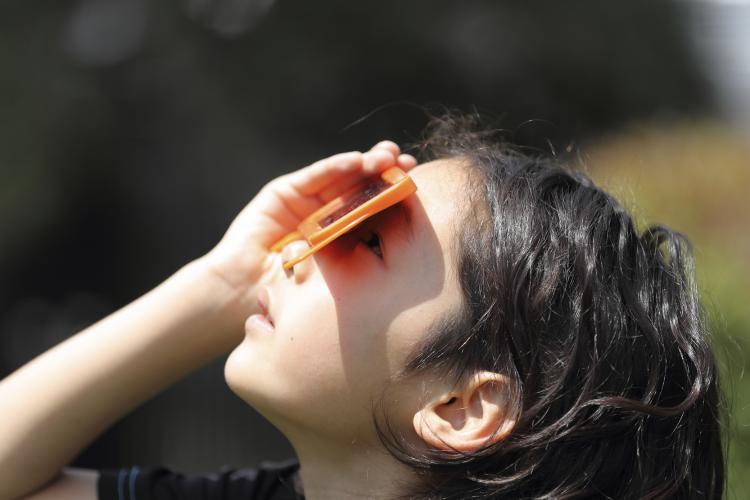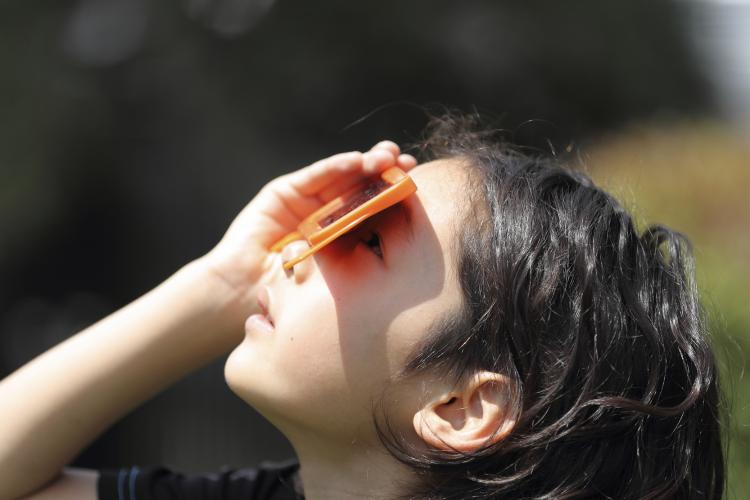
Viewing the eclipse directly, without proper protection, can permanently damage the eye. Some tips.
WORCESTER – Dr. Larry Baitch, associate dean for research in the School of Optometry at MCPHS University, knows how high interest is in viewing Monday’s solar eclipse. Most of the vendors selling glasses and filters certified to comply with ISO 12312-2, the filtering strength required to safely view the eclipse, have been out of stock for a week.
As an optometrist, he also knows how viewing the eclipse directly, without proper protection, can permanently damage the eye.
Officials at MCPHS University School of Optometry are offering to help people in the Worcester community view this cosmic event by providing 100 pairs of complimentary eclipse glasses on a first-come, first-served basis. Those interested should see Jerry Hastings, optical manager, at 10 Optical, 10 Lincoln Square in Worcester, from 2 to 4:30 p.m. Friday.
“We’re recommending filters that are actually approved for the wavelength,” not regular sunglasses, Dr. Baitch said.
For a swath of the country from Lincoln Beach, Oregon, to Charleston, South Carolina, the eclipse will be complete, meaning the moon will pass in front of the sun, blocking its light completely and creating a 70-mile wide shadow, for approximately two-and-a-half minutes.
The Worcester area is outside the path of totality, so the sun will only be 64 percent obscured. From this viewing area, the eclipse will start at 1:27 p.m., reach its peak around 2:45 p.m. and end by 4 p.m.
Because the sun’s powerful radiation, including ultraviolet and infrared light, won’t be blocked during the eclipse, Dr. Baitch said, “In Worcester, there is no safe time to look at the eclipse with your naked eyes.”
He explained that the eye focuses light on the retina at the back of the eye. When you look at the sun, “You’re focusing all the energy of the sun on a very small point on the retina and you can wind up with solar retinopathy.”
In essence, you’re burning what could be a permanent blind spot, a little black dot the shape of the sun, on the back of your eye, if you gaze at it for more than a moment.
The precise area of damage, the macula, is at the center of the field of vision, where detailed information such as print and color definition are processed.
“Most of the damage will occur after you’ve looked at it,” Dr. Baitch said. So there’s no warning that you should look away.
Besides wearing appropriately filtered glasses, Dr. Baitch highlighted other safe ways to view the eclipse:
‒ Make a pinhole in a sheet of paper. Without looking directly at the sun, hold the paper up so the sunlight comes through the hole and shines through onto another sheet of paper or the ground. What you’ll see is a projection of the eclipse.
‒ The same principle applies in magnification to sunlight filtering through tree leaves. Look at the side of a building near a tree, such as a garage door. “You’ll see thousands and thousands of eclipses,” Dr. Baitch said.
‒ View the eclipse through a telescope with the proper sun filter in front of the lens closest to the sun, away from your eye.
‒ Watch the eclipse on a live stream. NASA has created a special website, https://eclipse2017.nasa.gov/, for real-time viewing and other eclipse features.
Dr. Baitch said it’s safe to be outside during an eclipse, as long as you’re not looking at the sun.
He also warned that the harmful rays can get through even if it’s cloudy, so precautions should still be taken.
“This is the first time it’s been complete from coast to coast in almost a hundred years,” Dr. Baitch said.
[“Source-telegram”]
